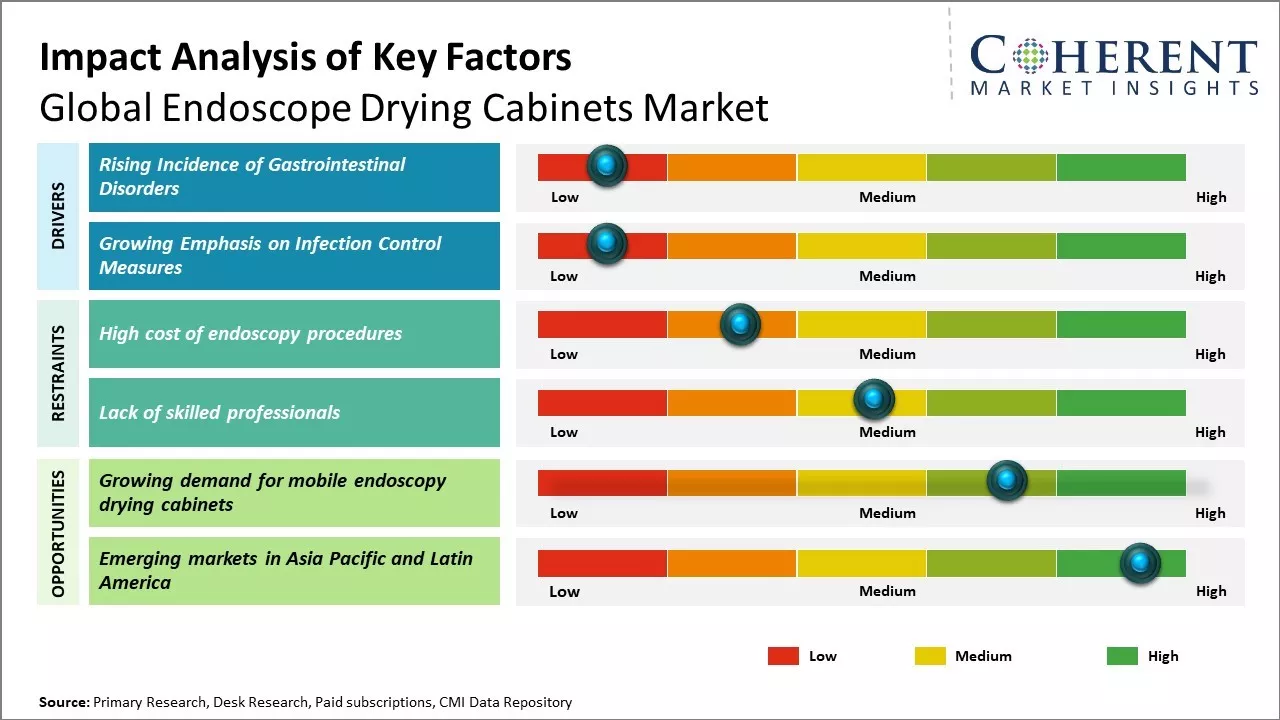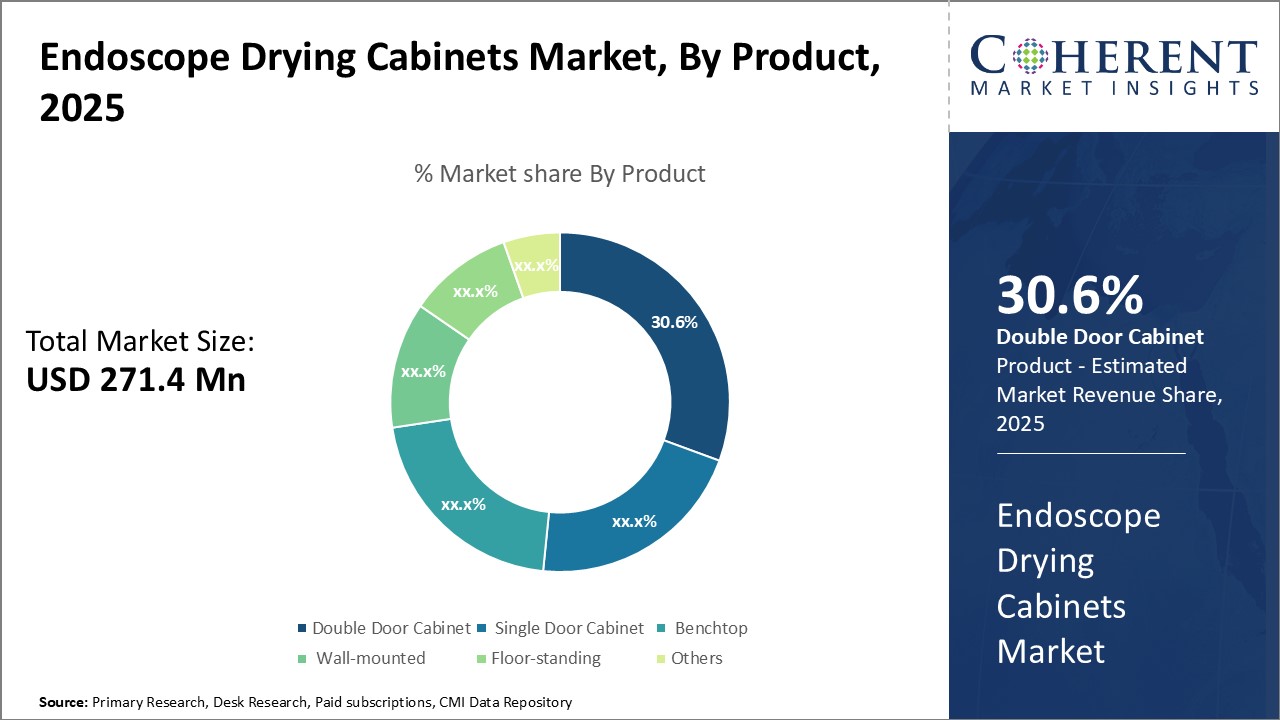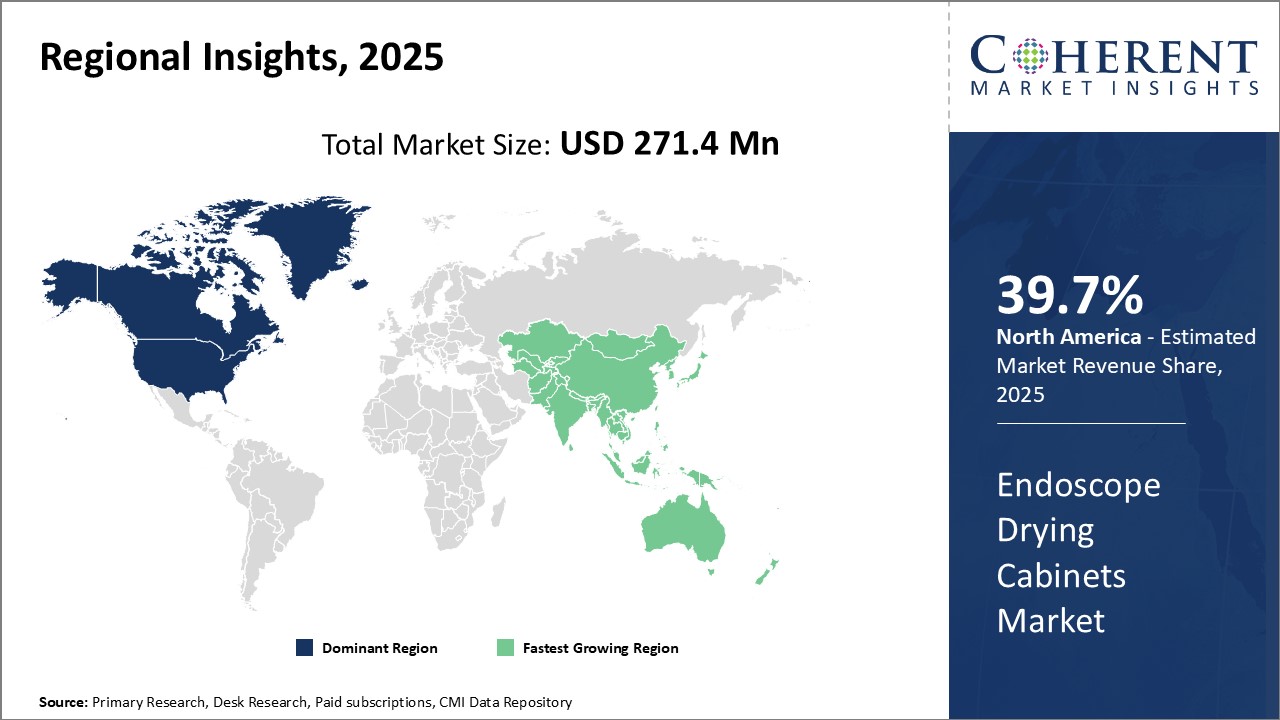Endoscope Drying Cabinets Market Size and Trends
Global endoscope drying cabinets market is estimated to be valued at USD 271.4 Mn in 2025 and is expected to reach USD 480.7 Mn by 2032, exhibiting a compound annual growth rate (CAGR) of 8.5% from 2025 to 2032.

Discover market dynamics shaping the industry: Download Free Sample
Global endoscope drying cabinets market is expected to witness growth during the forecast period due to factors such as rising prevalence of chronic diseases and increasing number of endoscopy procedures performed worldwide. Growing demand for advanced medical facilities with technologically advanced equipment in healthcare institutions can also boost demand for endoscope drying cabinets. Manufacturers are focusing on developing energy efficient and autonomous drying cabinets with advanced features such as UV lights and hydrogen peroxide generators for disinfection of endoscopes to gain competitive advantage. Furthermore, rising medical tourism in developing nations due to availability of low-cost treatments can boost the installation of endoscope drying cabinets in healthcare facilities in the near future.
Rising Incidence of Gastrointestinal Disorders
Rising prevalence of gastrointestinal disorders across the world has boosted the adoption of endoscopy procedures. According to latest studies, there has been increase in cases of gastric ulcers, inflammatory bowel disease, esophageal cancer and others. These medical ailments have put millions of sufferers under immense pain and discomfort. Gastrointestinal endoscopy plays a pivotal role in diagnosing the root cause of disease and determining the course of treatment in such cases. Due to rising patient pool of various GI tract related diseases, healthcare facilities are conducting more and more endoscopy tests on daily basis, and this boosts demand for endoscope equipment. Proper drying and disinfecting of endoscopes after each endoscopy cycle is imperative to prevent cross-contamination and infections in subsequent patients. This has amplified the requirement of endoscope drying cabinets that serve to be an ideal and standardized solution for disinfecting multi-patient use endoscopes between medical procedures in healthcare settings. For instance, in February 2023, according to an article published by National Library of Medicine, the global increase in gastrointestinal (GI) cancers and other chronic noncommunicable diseases can be attributed to societal shifts linked to socioeconomic development and urbanization. These changes lead to alterations in the microbiome, as well as genetic and epigenetic modifications among populations adopting Westernized lifestyles. The spread of this lifestyle globally contributes to a uniform industrial gut microbiota characterized by proinflammatory traits, which are associated with rising GI cancers and other chronic diseases.
Market Concentration and Competitive Landscape

Get actionable strategies to beat competition: Download Free Sample
Growing Emphasis on Infection Control Measures
Growing focus among healthcare providers as well as regulatory authorities on implementing stringent infection control practices and guidelines in endoscopy units can drive the market growth. Endoscope-associated infections can spread dangerous pathogens and put patient safety at high risk. It is imperative for endoscopy centers and hospitals to adopt utmost precaution in cleaning, disinfecting and drying medical devices that are inserted into human bodies. Manual air drying of endoscopes leaves scope for residual moisture and does not nullify all microbes completely. Meanwhile, improper drying increases the bioburden and chances of device-related infections. Joint Commission International and American Society for Gastrointestinal Endoscopy have made endoscope reprocessing protocols more rigorous. It recommends using dedicated endoscope drying cabinets that deploy validated drying cycles to eliminate moisture and guarantee complete disinfection before endoscope storage and next clinical use. With healthcare industry prioritizing patient safety and moving towards compliance with global quality standards, endoscope drying cabinets market can witness growth.
Key Takeaways from Analyst:
Global endoscope drying cabinets market growth is driven by rising demand for endoscopy procedures worldwide due to growing geriatric population and increasing prevalence of gastrointestinal diseases. Increasing healthcare expenditure and awareness regarding the importance of disinfecting and sterilizing endoscopes can also drive the market growth.
High costs associated with advanced automated endoscope drying cabinets can hamper their adoption, especially in price sensitive developing regions. Stringent regulatory approvals for new products can also hamper the market growth.
North America region currently dominates the market due to well-established healthcare systems and widespread medical insurance coverage in the region. Asia Pacific exhibits highest growth potential, owing to rapidly developing healthcare infrastructure, rising medical tourism, and growing discretionary incomes in countries like India and China.
In terms of product, automated endoscope drying cabinets will account for maximum market share due to advantages like reduced contamination risks, standardized operating protocols, and consistent drying performance. Modular systems provide increase storage capacity and flexibility which benefits multi-endoscopist settings.
Market Challenges: High cost of endoscopy procedures
The high cost of endoscopy procedures can hamper the global healthcare reimbursement market growth. Endoscopy procedures such as colonoscopies and upper gastrointestinal endoscopies are expensive diagnostics and treatment procedures that involve the use of advanced medical equipment and highly skilled healthcare professionals. For instance, according to the Centers for Disease Control and Prevention (CDC), the average cost of a colonoscopy without insurance in the U.S. is around US$ 1,000-US$ 1,500. An upper endoscopy procedure costs around US$ 800- US$ 1,200 on average without insurance. This high out-of-pocket cost of such specialized procedures poses a significant financial burden for many patients. Thus, many people tend to avoid or delay such medically important procedures. The high cost also puts pressure on the healthcare reimbursement programs and insurance providers. Reimbursing the full costs of many endoscopy claims erodes their profits. This makes it difficult for the private players and public insurers to scale up the healthcare coverage in a sustainable way.
Market Opportunities: Growing demand for mobile endoscopy drying cabinets
Growing demand for endoscopy procedures around the world leads to increased need for efficient cleaning and drying solutions. As healthcare systems strive to address more patients amid resource constraints, there is opportunity to optimize workflows and throughput with new cabinet technologies. Mobile endoscope drying cabinets specifically could help ease bottlenecks by streamlining reprocessing steps. These cabinets provide a contained, regulated environment to safely and effectively dry heat-sensitive endoscopes, helping minimize risks of contamination compared to air drying alone. With automatic controls and performance tracking, these reduce technician hands-on time per scope. This allows for higher productivity and capacity gains within endoscopy reprocessing areas. Some advanced models even integrate Scoped technology to automate record-keeping per medical device.

Discover high revenue pocket segments and roadmap to it: Download Free Sample
Insights, By Product - Double Door Cabinet segment contributes the highest share of the market due to its advanced features
By product, double door cabinet segment is estimated to contribute the highest market share of 30.6% in 2025, due to continuous innovation and new product launches by key players. Double door cabinets offer advanced features like separate chambers for storing scopes during and after disinfection. This dual chamber functionality allows for improved workflow efficiency as users can load clean scopes in one chamber while drying and storing used ones in another. The ergonomic double door designs with wide internal spacing also ensure convenient scope access and handling. Furthermore, manufacturers are integrating touchscreen controls and automated programming of drying cycles tailored for different endoscope types. This enhances safety, reproducibility and regulatory compliance of the reprocessing process.
Insights, By Size - 8 Endoscope segment leads due to its widespread adoption across settings
By size, 8 endoscope segment is estimated to contribute the highest market share of 30.22 % in 2025, due to its flexibility of usage in various healthcare settings. Most ambulatory centers and physician clinics have inventory of up to 8 flexible gastrointestinal endoscopes and bronchoscopes that require regular reprocessing. The compact designs of 8 endoscope cabinets fit well in locations often having space constraints. Furthermore, some small hospitals also opt for 8 endoscope cabinets as their endoscopy case load does not exceed this capacity on a daily basis. The standardized sizing offers compatibility with all major endoscope brands. It allows users to batch-process a convenient number of scopes simultaneously. This achieves optimal utilization of cabinets and promotes higher turnover of reprocessed devices.
By End User - Hospitals contribute highest share, owing to large inventory and oversight needs
By end user, hospitals segment is estimated to contribute the highest market share of 40.81% in 2025, due to stringent quality regulations that hospitals need to comply with. Hospitals perform high volumes of complex endoscopic procedures on a daily basis using a large inventory of expensive endoscopic devices. Non-compliance with processing and storage guidelines can risk patient safety and invite legal liabilities. Moreover, regulatory bodies conduct periodic audits of reprocessing practices in hospitals. To satisfy compliance, hospitals require professional-grade automated endoscope dryers having audit trails and user management systems. Hospitals also prefer products meeting quality certification and regulatory clearance standards. Leading cabinet OEMs offer a wide selection of medical-grade cabinets customized for hospital workflows.
Regional Insights

Need a Different Region or Segment? Download Free Sample
North America dominates the global endoscope drying cabinets market with an estimated market share of 39.7% in 2025, owing to high healthcare spending and well-developed healthcare infrastructure in countries like the U.S. and Canada. The region has strong presence of key market players as well as availability of advanced endoscope drying cabinet products. Moreover, growing end user preference for automated endoscope reprocessors over manual cleaning in this region boosts demand for endoscope drying cabinets. North America is one of the largest markets for endoscopic procedures that boosts the sales of endoscope drying cabinets.
Asia Pacific is expected to be fastest growing region in the market. Factors such as improving healthcare infrastructure, rising medical tourism, and increasing investments by governments boosts endoscope procedures in Asia Pacific countries. This boosts the uptake of endoscope drying cabinets. China represents a major opportunistic market owing to its huge patient population and growing focus towards development of healthcare facilities. Furthermore, increasing collaboration between global players and local Asian manufacturers is positively impacting the availability and adoption of technologically advanced products in the region. Low production costs and presence of manufacturing hubs in countries such as China and India makes Asia Pacific an attractive market for endoscope drying cabinet manufacturers.
Market Report Scope
Endoscope Drying Cabinets Market Report Coverage
| Report Coverage | Details | ||
|---|---|---|---|
| Base Year: | 2024 | Market Size in 2025: | USD 271.4 Mn |
| Historical Data for: | 2020 To 2024 | Forecast Period: | 2025 To 2032 |
| Forecast Period 2025 to 2032 CAGR: | 8.5% | 2032 Value Projection: | USD 480.7 Mn |
| Geographies covered: |
|
||
| Segments covered: |
|
||
| Companies covered: |
Olympus, Gallay Medical & Scientific, Stanley Healthcare, Smartline Medical Pty Ltd, MEDIVATORS Inc., Elmed Electronics & Medical Industry & Trade Inc., Choyang Medical Industry, Inc., Torvan Medical, DGM Pharma-Apparate Handel, Medical Devices Group, Wassenburg Medical, Arc Healthcare Solutions, Steris Plc, Cantel Medical, Steelco S.p.A., Belimed AG |
||
| Growth Drivers: |
|
||
| Restraints & Challenges: |
|
||
Uncover macros and micros vetted on 75+ parameters: Get instant access to report
Endoscope Drying Cabinets Industry News
- In November 2023, HOYA Corporation acquired the remaining 49% stake in WASSENBURG Medical B.V., a medical reprocessing company, thus, making it the sole owner of the company. WASSENBURG Medical specializes in manufacturing systems, consumables, and services for the complete endoscope reprocessing cycle worldwide. This acquisition aims to enhance innovation in endoscope reprocessing solutions by leveraging the engineering capabilities of WASSENBURG Medical alongside HOYA's PENTAX Medical flexible endoscopy division.
- In July 2023, Capsa Healthcare acquired MASS Medical Storage, a leading manufacturer that is known for its high-quality medical storage solutions and endoscope cabinet drying systems. These products enhance workflow efficiency and safety across various healthcare settings including GI Labs, Operating Rooms, Hybrid ORs, Cath Labs, Emergency Departments, Orthopedic units, and related procedure areas.
- In December 2022, PENTAX Medical, a division of HOYA Group, a global med-tech company, introduced the PlasmaTYPHOONdry, a new fast endoscope drying solution aimed at enhancing productivity and traceability while improving patient safety. This system aligns with PENTAX Medical's Hygiene Commitment, focusing on innovation, process optimization, and customer feedback to address infection prevention and patient safety effectively. The launch of PlasmaTYPHOONdry underscores PENTAX Medical's dedication to these critical healthcare priorities.
*Definition: Global Endoscope Drying Cabinets market covers devices used for drying medical endoscopes after cleaning and high-level disinfection. Endoscope drying cabinets provide a controlled, temperature-regulated environment to dry endoscopes thoroughly and efficiently between cases. These prevent recontamination and ensure endoscopes are completely dry before storage. Key features of endoscope drying cabinets include adjustable shelves, temperature and humidity control, air filtration and circulation, alarms and data logging. The market comprises manufacturers and distributors serving hospitals, ambulatory surgery centers and clinics.
Market Segmentation
- Product Insights (Revenue, USD Mn, 2020 - 2032)
- Double Door Cabinet
- Single Door Cabinet
- Benchtop
- Wall-mounted
- Floor-standing
- Others
- Size Insights (Revenue, USD Mn, 2020 - 2032)
- 8 Endoscope
- 12 Endoscope
- 16 Endoscope
- Others
- End User Insights (Revenue, USD Mn, 2020 - 2032)
- Ambulatory Surgical Centers
- Hospitals
- Clinics
- Others
- Regional Insights (Revenue, USD Mn, 2020 - 2032)
- North America
- U.S.
- Canada
- Latin America
- Brazil
- Argentina
- Mexico
- Rest of Latin America
- Europe
- Germany
- U.K.
- Spain
- France
- Italy
- Russia
- Rest of Europe
- Asia Pacific
- China
- India
- Japan
- Australia
- South Korea
- ASEAN
- Rest of Asia Pacific
- Middle East
- GCC Countries
- Israel
- Rest of Middle East
- Africa
- South Africa
- North Africa
- Central Africa
- North America
- Key Players Insights
- Olympus
- Gallay Medical & Scientific
- Stanley Healthcare
- Smartline Medical Pty Ltd
- MEDIVATORS Inc.
- Elmed Electronics & Medical Industry & Trade Inc.
- Choyang Medical Industry, Inc.
- Torvan Medical
- DGM Pharma-Apparate Handel
- Medical Devices Group
- Wassenburg Medical
- Arc Healthcare Solutions
- Steris Plc
- Cantel Medical
- Steelco S.p.A.
- Belimed AG
Share
Share
About Author
Manisha Vibhute is a consultant with over 5 years of experience in market research and consulting. With a strong understanding of market dynamics, Manisha assists clients in developing effective market access strategies. She helps medical device companies navigate pricing, reimbursement, and regulatory pathways to ensure successful product launches.
Missing comfort of reading report in your local language? Find your preferred language :
Transform your Strategy with Exclusive Trending Reports :
Frequently Asked Questions
EXISTING CLIENTELE
Joining thousands of companies around the world committed to making the Excellent Business Solutions.
View All Our Clients
